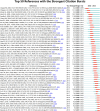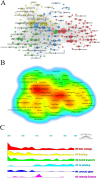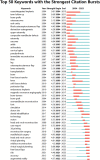Fibular grafts in global reconstructive surgery: a bibliometric analysis
- PMID: 39624462
- PMCID: PMC11609196
- DOI: 10.3389/fsurg.2024.1479878
Fibular grafts in global reconstructive surgery: a bibliometric analysis
Abstract
Background: Over the past few decades, fibular grafts have been widely utilized across 86 countries and regions globally for surgical reconstruction of various anatomical sites, including the mandible, upper extremities, lower extremities, spine, and in phalloplasty procedures. The present study aims to systematically investigate the developmental trajectory of fibular graft and identify research priorities for surgeons.
Methods: A bibliometric analysis was conducted by searching the Web of Science Core Collection on April 12, 2024, for articles published between 2004 and 2023 on fibular grafting, using the query TS = ("graft" OR "transfer" OR "flap") AND TS = ("fibular"). We included full-text English articles and reviews, and exclude documents that were not related to fibular grafting or were non-research-oriented publications. GraphPad Prism, CiteSpace, and VOSviewer analyzed publication trends and co-citation networks, providing insights into fibular grafting research.
Results: A total of 2,884 fibular graft publications were analyzed. Out of 86 countries/regions, the United States and China stood out as the main contributors in terms of publication volume, while England had the highest citation rate per publication. The journals with the most publications and citations were The Journal of Craniofacial Surgery and Plastic and Reconstructive Surgery, respectively. Mark K. Wax had the most publications, while Hidalgo DA had the highest co-citation count. The most frequently occurring keywords were "reconstruction" and "mandibular reconstruction." Co-citation reference clustering revealed a growing preference for vascularized fibular grafts over non-vascularized alternatives. The top 10 co-cited references were exclusively focused on mandibular reconstruction. Keyword bursts analysis showed that over the initial 20-year period, identified keywords fall into three main themes: graft design (e.g., osteoseptocutaneous flap, perforator flap), reconstruction areas (e.g., maxilla, extremity, ankle, spine and phalloplasty), and defect causes (e.g., pseudarthrosis, sarcoma, bone tumor). In particular, fibular grafts in phalloplasty represent an emerging trend among various anatomical reconstruction sites. In the last 5 years, there has been a notable rise in interest in 3D planning, virtual surgical planning, augmented reality, and reconstruction accuracy.
Conclusion: The findings offer an in-depth overview of the landscape of fibular graft research, highlighting key contributors and emerging trends.
Keywords: bibliometric study; fibular grafts; orthopedic surgery; reconstructive surgery; research trends.
© 2024 Zhang, Li, Cheng, Deng and Cai.
Conflict of interest statement
The authors declare that the research was conducted in the absence of any commercial or financial relationships that could be construed as a potential conflict of interest.
Figures








Similar articles
-
Global trends in research of acute type a aortic dissection: A bibliometric analysis from 2002 to 2022.Heliyon. 2023 Jul 5;9(7):e17955. doi: 10.1016/j.heliyon.2023.e17955. eCollection 2023 Jul. Heliyon. 2023. PMID: 37501968 Free PMC article.
-
Two decades of progress in glioma methylation research: the rise of temozolomide resistance and immunotherapy insights.Front Neurosci. 2024 Sep 2;18:1440756. doi: 10.3389/fnins.2024.1440756. eCollection 2024. Front Neurosci. 2024. PMID: 39286478 Free PMC article.
-
Insight into the research history and trends of total anomalous pulmonary venous connection: a bibliometric analysis.J Cardiothorac Surg. 2024 May 11;19(1):285. doi: 10.1186/s13019-024-02787-8. J Cardiothorac Surg. 2024. PMID: 38730414 Free PMC article.
-
Research trends in the field of the gut-brain interaction: Functional dyspepsia in the spotlight - An integrated bibliometric and science mapping approach.Front Neurosci. 2023 Mar 8;17:1109510. doi: 10.3389/fnins.2023.1109510. eCollection 2023. Front Neurosci. 2023. PMID: 36968499 Free PMC article. Review.
-
The top 100 most cited articles on intramedullary nail fixation from 2018-2022: a bibliometric and visualized analysis.Eur Rev Med Pharmacol Sci. 2024 Mar;28(5):1662-1679. doi: 10.26355/eurrev_202403_35582. Eur Rev Med Pharmacol Sci. 2024. PMID: 38497851 Review.
References
LinkOut - more resources
Full Text Sources
Miscellaneous

